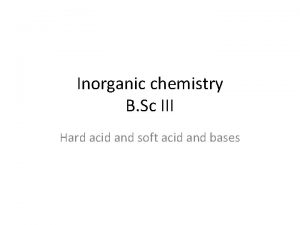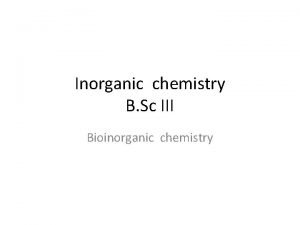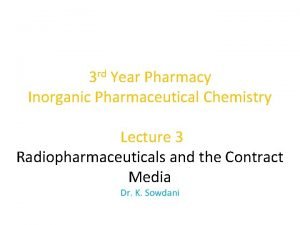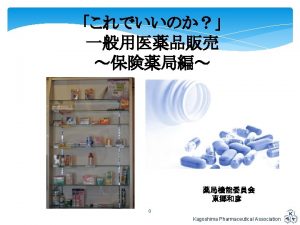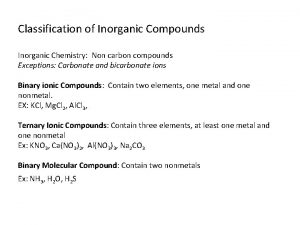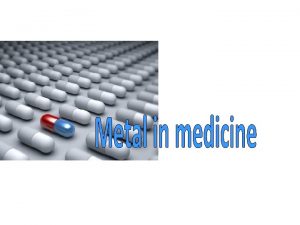Inorganic Pharmaceutical Chemistry Lecture 5 Chapter Eleven the














- Slides: 14

Inorganic Pharmaceutical Chemistry Lecture 5 Chapter Eleven the Contract Media

Radiopaque Contrast Media Radiopaque media are chemical compounds containing elements of high atomic number which will stop the passage of x rays. These types of compounds are used as diagnostic aids in radiology or roentgenology. Roentgenology involves the use of X rays(roentgen rays), which are short wavelength electromagnetic radiation, in the imaging or shadowing of various internal organic structures.

X rays are capable of passing through most soft tissue so that when special photographic film or a photosensitive plate is placed on the side of the patient opposite to the x ray source, the film or plate will become darkened in an amount proportional to the number of x ray photons that are able to pass. Bone and teeth are the only types of tissue capable of significantly arresting the passage of X rays.

Radiopaque materials appear light on exposed x ray film, allowing their visualization for the diagnosis of fractures, malformations, and the like. The chemical constituents of bone and teeth which give them the ability to stop this type of radiation are the large concentrations of calcium and phosphorus. Although these elements do not have tremendously high atomic numbers, they represent the highest available in biological systems in any significant concentration.

Furthermore, they occur in close packed structures provid ing large localizations of electron density. As a general rule, the more electrons in an atom or molecule the greater the chance of stopping the passage of x rays. Soft tissues, being less dense and composed primarily of carbon, hydrogen, and oxygen, which are relatively low in atomic number, do not present a dense enough electron "screen" or barrier. For this reason skin and soft organs appear only as shadows, if at all, on x ray film.

The most common radiopaque contain barium and iodine. The iodine compounds are covalently bonded organic iodides. These compounds are used for x ray examinations of the kidney, liver, blood vessels, heart, and brain. Covalent organic iodides are nonionic, and the organic molecule usually has some affinity for the organ system to be studied. Only one compound of barium is useful as a radiopaque, barium sulfate.

Other salts of barium exhibit some solubility and thus provide toxic barium ion. Therefore, barium sulfate is essentially the only inorganic compound in this class of agents. Although both barium and iodine do not have the highest atomic numbers, they are the most easily incorporated into molecules exhibiting relatively low toxicity. Their opacity to x rays is dependent upon their being highly concentrated in the organ to be studied, and they have served quite well as contrast media in the x ray examination of soft tissues.

Barium Sulfate, U. S. P. XVIII (Ba. S 04; Mol. Wt, 233. 40 Barium sulfate insoluble in water, organic solvents, and solutions of acids and alkalies. The insolubility of barium sulfate limits the ability of the compound to enter into chemical reactions. It will react with concentrated sulfuric acid to form the soluble bisulfate salt.

Barium sulfate is the agent of choice in roentgenographic studies of the "gastrointestinal tract. Its insolubility in acidic gastric juice is a major criterion for this use. Caution—When Barium Sulfate is prescribed, the title always should be written out in full to avoid confusion with the poisonous barium sulfide or barium sulfite. Although barium ion generally is not available in this product, certain aspects of its pharmacology should be mentioned with respect to its toxicity.

Barium ion will produce a stimulation of all muscles. In the gastro intestinal tract, this is seen as a stimulation of the smooth muscle resulting in vomiting, severe cramps, diarrhea, and possible hemorrhage. Stimula tion of the heart muscle can produce cardiac arrest as the cause of death.

In fact, caution has been suggested in the use of Ba. S 04 in cardiac patients. Hypertension can result from constriction of the smooth muscle of the arteries. The effect on skeletal muscle is similar, producing tremors and spasms. The systemic absorption of 800 mg of a soluble barium salt is sufficient to produce death. Ba. S 04 is employed in suspensions of various concentrations for use in the G. I, tract.

A paste of the compound will remain in the esophagus long enough for roentgenbgraphic or fluoroscopic study. The suspensions are administered orally or by enema after fasting. The major side effect associated with the use of barium sulfate suspensions is constipation. Accidental entry of barium sulfate into the peritoneal and other cavities through perforations and the like has produced little in the way of severe reactions or inflammation.

Organoiodine Radiopaque compounds. There a number of official iodine containing organic compounds used in diagnosis by roentgenography. The following is a partial listing of these agents and their primary uses. Meglumine Diatrizoate and Sodium Iodipamide These agents are used in cerebral angiography (visualization of cerebral blood vessels) and gastrointestinal studies the meglumine salts is used in coronary angiography.

THANK YOUI
 Inorganic pharmacy
Inorganic pharmacy Advanced inorganic chemistry lecture notes
Advanced inorganic chemistry lecture notes Organic vs inorganic chemistry
Organic vs inorganic chemistry Ch4o organic or inorganic
Ch4o organic or inorganic Inert pair effect
Inert pair effect Hard soft acid base theory
Hard soft acid base theory 01:640:244 lecture notes - lecture 15: plat, idah, farad
01:640:244 lecture notes - lecture 15: plat, idah, farad Atmospheric chemistry lecture notes
Atmospheric chemistry lecture notes Functional groups ib chemistry
Functional groups ib chemistry Hát kết hợp bộ gõ cơ thể
Hát kết hợp bộ gõ cơ thể Slidetodoc
Slidetodoc Bổ thể
Bổ thể Tỉ lệ cơ thể trẻ em
Tỉ lệ cơ thể trẻ em Gấu đi như thế nào
Gấu đi như thế nào Thang điểm glasgow
Thang điểm glasgow





